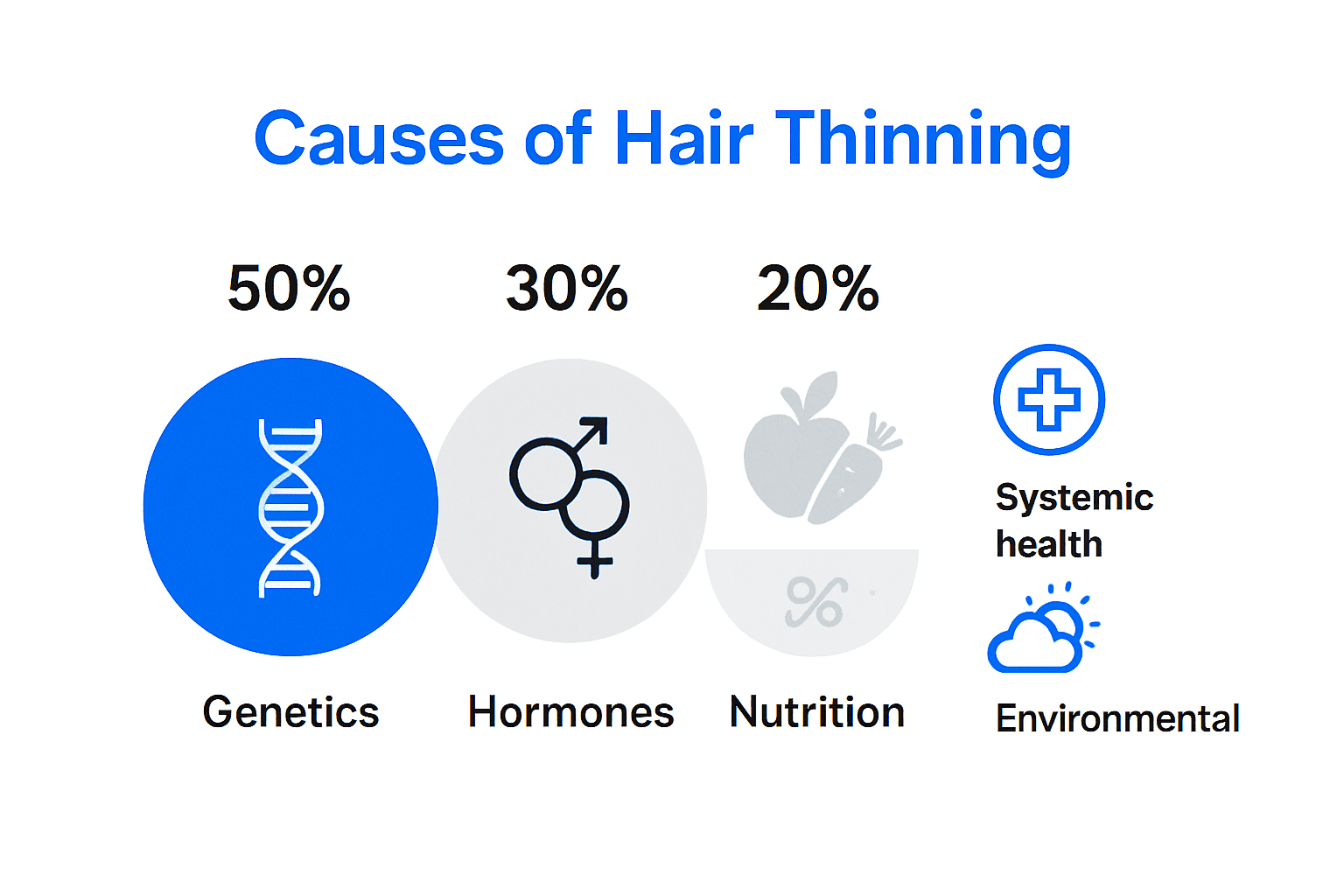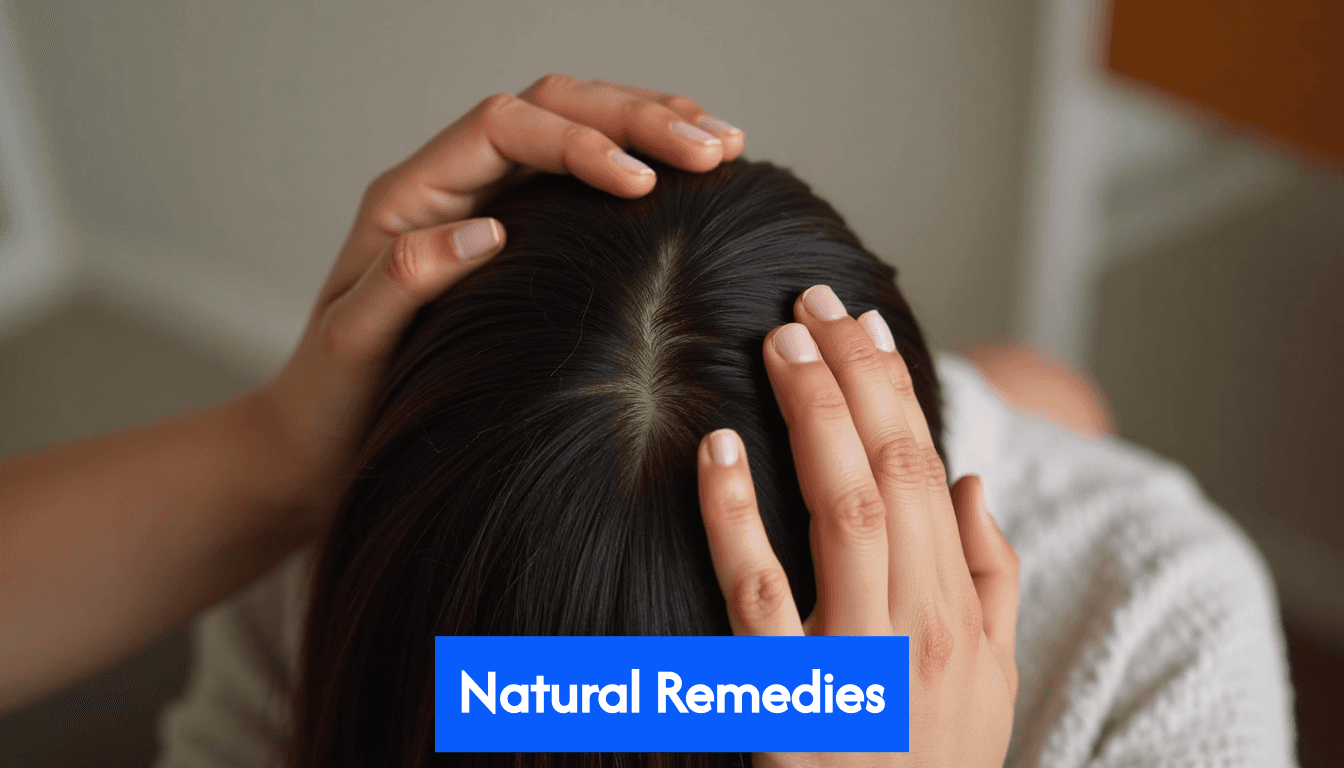Blog
Learning Materials
Best Proven Methods for Thick Hair Growth in 2025
Updated: June 9, 2025

Hair thinning is not just a cosmetic nuisance. Over 50 percent of women and 80 percent of men experience noticeable hair loss by age 50. Most people immediately reach for expensive serums and trends promising instant results. Sounds promising, right? Surprisingly, the true solution is much deeper than another bottle on the shelf. Real, lasting thick hair growth in 2025 starts with understanding your roots quite literally and scientifically. Ready for facts that flip your expectations about what actually works?
Table of Contents
- Understanding Causes Of Thinning Hair
- Top Natural Remedies For Thick Hair Growth
- Personalized Hair Care Routines For Growth
- Tracking Progress And Setting Realistic Goals
Quick Summary
| Takeaway | Explanation |
|---|---|
| Understand underlying causes of hair thinning | Recognizing factors like genetic predisposition, hormonal imbalances, and nutritional deficiencies is essential for effective hair growth strategies. |
| Incorporate natural remedies into your routine | Utilize herbal extracts like rosemary oil and pumpkin seed oil, as well as nutrient-rich treatments like onion juice and amla, to promote hair growth naturally. |
| Adopt personalized hair care practices | Leverage technology-driven hair analysis and customized formulations to create tailored routines that address individual hair needs. |
| Implement systematic tracking and goal setting | Use baseline measurements and maintain a detailed growth journal to monitor progress and adapt strategies as needed for optimal results. |
Understanding Causes of Thinning Hair
Hair loss is a complex biological process influenced by multiple interconnected factors. Understanding these underlying causes is crucial for developing effective strategies for thick hair growth. Unlike popular misconceptions, thinning hair results from a sophisticated interplay of genetic, hormonal, environmental, and physiological mechanisms.

Genetic and Hormonal Triggers
Androgenetic alopecia represents the most prevalent form of hair loss, affecting both men and women. Research from the National Center on Aging reveals that genetic predisposition plays a significant role in hair thinning. Hormonal imbalances specifically disrupt hair follicle function through several mechanisms. Dihydrotestosterone (DHT), a potent androgen hormone, can shrink hair follicles and progressively reduce hair shaft diameter. Women experiencing conditions like polycystic ovary syndrome (PCOS) or navigating hormonal transitions such as menopause frequently encounter increased hair thinning.
The biological complexity of hair loss extends beyond simple genetic inheritance. Our personalized hair analysis guide demonstrates how individual genetic markers interact with environmental factors to influence hair growth patterns. Certain genetic variations can make individuals more susceptible to hair follicle miniaturization and accelerated hair loss.
Systemic Health and Environmental Factors
Beyond genetics, numerous systemic health conditions contribute to hair thinning. Nutritional deficiencies in key micronutrients like iron, zinc, and vitamin D can significantly impair hair follicle function. Emerging research from dermatology experts highlights how chronic inflammation, oxidative stress, and autoimmune disorders can disrupt normal hair growth cycles.
Environmental stressors also play a critical role. Chronic psychological stress triggers hormonal cascades that can push hair follicles into premature resting phases. Exposure to pollutants, harsh chemical treatments, excessive heat styling, and poor nutrition compound the risk of accelerated hair thinning. Smoking, for instance, constricts blood vessels and reduces nutrient delivery to hair follicles, further compromising hair health.
Cellular Mechanisms of Hair Loss
At the microscopic level, hair loss involves complex cellular dynamics. Recent scientific discoveries from UVA Health reveal that hair follicle stem cells remain present even in baldness but become inactive. This groundbreaking insight suggests that potential treatments could focus on reactivating these dormant stem cells rather than attempting to regenerate them entirely.
Understanding these multifaceted causes empowers individuals to take proactive approaches to hair health. By recognizing the intricate biological processes behind hair thinning, people can develop targeted strategies that address root causes rather than merely treating surface-level symptoms. Comprehensive hair care requires a holistic approach that considers genetic predispositions, hormonal balance, nutritional status, and overall systemic health.
Top Natural Remedies for Thick Hair Growth
Natural remedies offer powerful solutions for stimulating hair growth and improving overall hair health without relying solely on synthetic treatments. These holistic approaches leverage botanical ingredients and traditional healing practices to support hair follicle function and promote thicker, more resilient hair.
Herbal Extracts and Essential Oils
Research from leading dermatological studies reveals an impressive array of herbal remedies with scientifically proven hair growth potential. Rosemary oil stands out as a particularly potent natural treatment, demonstrating comparable effectiveness to minoxidil in stimulating hair regrowth. Saw palmetto shows promising results in blocking DHT, the hormone responsible for pattern baldness. Korean red ginseng offers remarkable benefits by improving blood circulation to hair follicles and reducing inflammation.
Pumpkin seed oil emerges as another powerful natural remedy. Studies indicate it can significantly increase hair count and hair thickness by blocking testosterone conversion and providing essential nutrients. Olive oil and coconut oil provide deep conditioning, protecting hair from environmental damage and reducing protein loss. Our expert solutions guide explores how these natural ingredients can be integrated into a comprehensive hair care routine.
Nutrient-Rich Topical Treatments

Onion juice represents a surprising yet scientifically backed natural remedy for hair growth. Clinical research demonstrates its effectiveness in treating alopecia areata, with its high sulfur content supporting collagen production and improving blood circulation to hair follicles. The treatment works by stimulating dormant hair follicles and reducing inflammation.
Amla, a powerful Indian gooseberry extract, offers comprehensive hair health benefits. Rich in vitamin C and antioxidants, amla strengthens hair roots, prevents premature graying, and promotes scalp health. Its natural properties help combat oxidative stress and support the hair growth cycle. Other nutrient-dense treatments like aloe vera gel provide hydration, reduce scalp inflammation, and create an optimal environment for hair growth.
Holistic Approach to Natural Hair Restoration
Successful natural hair growth requires a holistic approach that combines topical treatments with internal nutrition and lifestyle modifications. Essential nutrients like biotin, zinc, and vitamin D play crucial roles in hair follicle health. Dietary interventions that include protein-rich foods, omega-3 fatty acids, and antioxidant-packed fruits and vegetables can significantly impact hair growth potential.
It is important to approach natural remedies with realistic expectations and consistency. While these treatments offer promising results, individual responses vary based on genetic factors, overall health, and specific hair conditions. Patience and a comprehensive approach that addresses underlying health factors are key to achieving optimal hair growth. Consulting with healthcare professionals can help develop a personalized strategy that combines natural remedies with targeted nutritional support for maximum effectiveness in promoting thick, healthy hair.
Personalized Hair Care Routines for Growth
Personalized hair care represents the future of hair growth strategies, moving beyond one-size-fits-all approaches to address individual hair characteristics and specific growth challenges. Our expert solutions guide emphasizes the importance of tailoring hair care routines to unique physiological needs and genetic predispositions.
Technology-Driven Hair Analysis
Emerging trends in beauty technology showcase advanced diagnostic tools that enable unprecedented personalization of hair care routines. Virtual consultations and AI-powered analysis now allow individuals to receive precise recommendations based on detailed scalp and hair assessments. These technologies analyze multiple factors including hair density, scalp health, moisture levels, and potential growth barriers.
Advanced diagnostic methods now incorporate genetic testing, hormonal profiling, and comprehensive nutritional assessments. By mapping individual hair growth patterns, these technologies can predict potential hair loss risks and develop targeted intervention strategies. Microbiome analysis of the scalp provides additional insights, revealing how specific bacterial environments impact hair health and growth potential.
Customized Natural Ingredient Formulations
Research from industry experts highlights the rising importance of natural, targeted oil treatments in personalized hair care. Specialized oil blends like coconut, argan, rosemary, and aloe vera are now being precisely formulated to address individual hair concerns. These natural ingredients offer specific benefits: coconut oil provides deep conditioning, argan oil supports hair elasticity, and rosemary oil stimulates follicle circulation.
The integration of adaptogens and food-inspired ingredients represents a holistic approach to hair care. Turmeric, known for its anti-inflammatory properties, and amla, rich in vitamin C, are being incorporated into personalized hair treatments. These ingredients are selected based on individual scalp conditions, hair texture, and specific growth objectives.
Holistic Personalization Strategy
Effective personalized hair care extends beyond topical treatments. A comprehensive approach considers lifestyle factors, nutritional intake, stress levels, and overall health. Customized supplement recommendations, tailored dietary guidance, and personalized stress management techniques complement external hair care routines.
Individuals now have access to comprehensive hair growth plans that dynamically adjust based on ongoing assessments. Tracking technologies enable real-time monitoring of hair growth progress, allowing for continuous refinement of treatment strategies. This data-driven approach ensures that hair care routines remain responsive to changing physiological conditions and individual needs.
The future of hair growth lies in understanding that each person's hair is as unique as their fingerprint. By embracing personalized technologies, natural ingredients, and holistic health strategies, individuals can develop targeted approaches that maximize their natural hair growth potential. The key is no longer about finding a universal solution, but creating a precisely tailored pathway to healthier, thicker hair.
Tracking Progress and Setting Realistic Goals
Successful hair growth strategies demand more than wishful thinking. Systematic tracking and goal setting transform hair care from a passive process to an active, measurable journey of personal transformation. Our comprehensive growth tracking guide provides insights into developing an effective monitoring approach.
Establishing Baseline Measurements
Documenting your current hair condition serves as the critical first step in any meaningful growth strategy. Professional tracking recommendations suggest using precise measurement techniques like dedicated length-check methods every four months. This approach allows you to objectively assess growth rates and retention. Measurements should include not just overall length, but also hair density, strand thickness, and scalp health indicators.
Photographic documentation provides visual evidence of incremental changes. Consistent photography under similar lighting conditions helps eliminate subjective interpretations. Recommended documentation includes full-length hair shots, close-up scalp images, and detailed strand analysis. These visual records create a comprehensive narrative of your hair growth journey, revealing subtle transformations that might otherwise go unnoticed.
Creating Personalized Growth Frameworks
Realistic goal setting requires understanding individual biological limitations. Average hair growth rates typically range between 0.5 to 1.7 centimeters per month, though individual variations exist. Breaking down long-term objectives into smaller, manageable milestones prevents discouragement and maintains motivation. A structured approach might involve quarterly growth targets, with specific metrics for length, thickness, and overall hair health.
Hair growth planners recommend maintaining detailed journals that track not just growth, but also product interactions, dietary changes, and lifestyle factors. These comprehensive logs help identify correlation between interventions and actual hair performance. By recording product reactions, nutritional intake, and stress levels, you create a holistic understanding of factors influencing hair growth.
Advanced Tracking and Adaptation Strategies
Modern hair growth tracking transcends traditional measurement techniques. Emerging technologies now offer microscopic hair follicle analysis, providing unprecedented insights into individual growth patterns. These advanced diagnostic tools can predict potential growth barriers, assess follicle health, and recommend targeted interventions.
Successful tracking is not about achieving perfection but understanding your unique hair journey. Flexibility remains crucial adaptation strategy. If initial approaches demonstrate limited effectiveness, being willing to modify your strategy based on documented evidence ensures continuous improvement. Regular consultations with hair health professionals can provide expert interpretations of your tracking data, offering refined recommendations.
Remember that hair growth is a complex, multifaceted process influenced by genetics, nutrition, stress, and overall health. Patience, consistent tracking, and a scientific approach transform hair care from a hope-based strategy to a data-driven personal optimization journey. By embracing systematic monitoring and maintaining realistic expectations, you unlock the potential for meaningful, sustainable hair growth.
Frequently Asked Questions
What are the main causes of thinning hair?
Hair thinning can be caused by a variety of factors, including genetic predisposition, hormonal imbalances, nutritional deficiencies, chronic inflammation, environmental stressors, and underlying health conditions.
How can natural remedies promote thick hair growth?
Natural remedies, such as herbal extracts and nutrient-rich treatments, can support hair follicle health and growth. Ingredients like rosemary oil, onion juice, and amla have demonstrated effectiveness in improving hair thickness and health.
What is personalized hair care, and why is it important?
Personalized hair care tailors routines to individual genetic traits and specific hair needs, utilizing technology-driven analysis and customized formulations. This approach ensures more effective treatments for hair growth than one-size-fits-all solutions.
How should I track my hair growth progress?
To track hair growth progress, establish baseline measurements, document changes through photos, and maintain a detailed journal of product use, dietary habits, and lifestyle factors. This systematic approach helps identify what works best for your hair health.
Ready to See Real Change in Your Hair Growth Journey?
You just learned why hair loss and thinning go deeper than surface solutions. The truth is, generic products rarely address unique issues like hormonal triggers, nutritional gaps, or the need for custom tracking. If you feel frustrated by slow progress or unsure which method works best for you, there is a smarter way to take control. Discover how advanced hair analysis and tech-driven personalization can turn proven methods into visible results tailored to you.

Start your transformation today with MyHair.ai. Upload a scan to receive an in-depth hair health analysis and get product recommendations personalized to your needs. Take the next step by tracking your progress and optimizing your routine with evidence-based guidance found in our expert solutions guide. Act now to move beyond guesswork and let real data power your path to thicker hair in 2025.
Recommended Articles
- Expert Tips for Healthy Hair Growth: Proven Strategies for Radiant, Luscious Locks | MyHair
- 2025 Proven Hair Loss Treatment: Best Options Guide | MyHair
- Simple Tricks to Help Hair Grow, Shine & Look Healthy | MyHair
- Stress Bald Spots on Head: Effective Management Tips | MyHair
- Hair Loss Clinic: Diagnosis, Treatment, and Prevention | MyHair